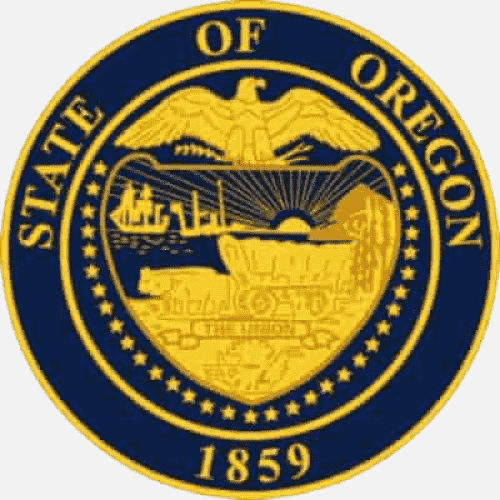 State Flag |  State Seal |
Oregon is a state in the Pacific Northwest of the United States. It is bordered on its west by the Pacific Ocean, north by Washington, south by California, east by Idaho, and southeast by Nevada.
- ABBREVIATION: OR
- NICKNAME: The Beaver State
- POPULATION: 4,272,371 (2024 est.)
- CAPITAL: Salem
- STATE BIRD: Western Meadowlark
- STATE FLOWER: Oregon Grape
- AREA: 98,381 sq. mi.
- TIME ZONE: Most of state: Pacific – most of Malheur County: Mountain
- ENTERED UNION: Feb. 14, 1859
- ALTITUDE: High, 11,249 ft. Mount Hood
- CLIMATE: Cold summers, mild winters, heavy rain along the coast and in Willamette Valley. Hot summers, cold winters in drier east.
Since the first pioneers pushed into the territory in the 1830’s, most Oregonians have settled in the Willamette Valley, a fertile trough bounded by the wide Columbia River, the coast and Cascade Ranges.
To the northwest lies Portland, a major inland port which exercises commercial sway over the state’s long-standing industries; fruit, vegetable, and fish canning, lumber, pulp, and paper production.
Since the establishment of the state’s first sawmill in 1832, the life of Oregon has been intertwined with its great forests of Douglas Fir and Western Pine. Forests cover more than 30 million of Oregon’s 62 million acres – nearly half of the state’s landmass.
As the number one lumber producer in the U.S., Oregon accounts for 18% of total U.S. softwood lumber production. Strict forest laws assure trees are planted and growing to replace timber harvested, thus, there has been almost no net loss in Oregon’s forest land since man arrived in the ‘Beaver’ State.

Crater Lake National Park, Oregon
For land hungry pioneers in the 1840’s, the Oregon Trail was the main route to the Pacific Coast after Dr. Elijah White’s emigrant train traversed it in 1842. The Trail, winding 2,000 miles from Independence, Missouri, partly paralleled the path of Lewis and Clark, the first to prove that the northwest coast, which had been explored by the sea, could be reached overland.
Use of the trail declined as the first transcontinental railroad was completed in 1869, thus making the trip west safer, cheaper, and faster.
Fun Facts:
- Oregon takes its nickname from the abundant beaver that gave rise to a thriving fur trade in the early1800s.
- The U.S. Department of Energy’s Bonneville Power Administration, headquartered in Portland, provides about 45 percent (2001 est.) of the electricity used in the Pacific Northwest. Most of this power comes from 31 hydroelectric plants along the Columbia River.
- During World War II, Japan tried unsuccessfully to start huge fires along the Oregon coast by launching fire bombs.
- Oregon’s state flag pictures a beaver on its reverse side. It is the only state flag to carry two separate designs.
- Crater Lake is the deepest lake in the United States. It was formed more than 6,500 years ago. Its crystal-blue waters are world renowned.
- Eugene was the first city to have one-way streets.
History:
Oregon, located in the Pacific Northwest of the United States, has a rich and diverse history shaped by Native American heritage, European exploration, pioneer settlement, and political evolution. Its development reflects the broader American story of expansion, environmental beauty, and cultural change.
For thousands of years before European contact, the land that is now Oregon was home to many Native American tribes, including the Chinook, Nez Perce, Klamath, Modoc, and Umatilla. These Indigenous groups developed complex societies based on fishing, hunting, and trading.
The Columbia River, one of the most significant waterways in the region, served as a major route for travel and commerce among tribes. Salmon fishing and seasonal gatherings were central to their way of life.
The first recorded Europeans to reach the Oregon coast were Spanish explorers in the 16th century, but the area remained largely untouched by colonization for centuries. British and American fur traders, notably those associated with the Hudson’s Bay Company and the American Fur Company, began to explore and establish trading posts in the late 1700s and early 1800s.
In 1805, the Lewis and Clark Expedition reached the Pacific Ocean at the mouth of the Columbia River, strengthening U.S. claims to the region.
Throughout the early 19th century, Oregon was part of a disputed area claimed by both the United States and Britain. This “Oregon Country” included present-day Oregon, Washington, Idaho, and parts of Montana and Canada.
American interest in the region grew during the 1830s and 1840s, as settlers traveled west on the Oregon Trail, a 2,000-mile route that stretched from Missouri to the Willamette Valley. The promise of fertile land attracted thousands of pioneers.
The Oregon Trail became a symbol of Manifest Destiny, the belief that the United States was destined to expand across the continent. The influx of American settlers led to increased pressure to resolve the territorial dispute.
In 1846, the U.S. and Britain signed the Oregon Treaty, which set the boundary at the 49th parallel, granting most of the territory to the United States.
In 1848, Oregon became an official U.S. territory, and on February 14, 1859, it was admitted to the Union as the 33rd state. Oregon’s early economy centered around agriculture, timber, and fishing. Its vast forests and natural resources helped fuel economic growth, while its coastline and rivers supported trade and transport.
During the 20th century, Oregon became known for its progressive politics, environmental awareness, and scenic beauty. The state played a role in both World Wars, producing ships and lumber. In the postwar era, Oregon experienced rapid growth in cities like Portland and Eugene, along with a rising interest in environmental conservation.
Today, Oregon is recognized for its natural diversity, from the Pacific Ocean and Cascade Mountains to high desert plains. Its history—from Native heritage and pioneer journeys to statehood and modern innovation—embodies the American spirit of exploration, resilience, and adaptation.